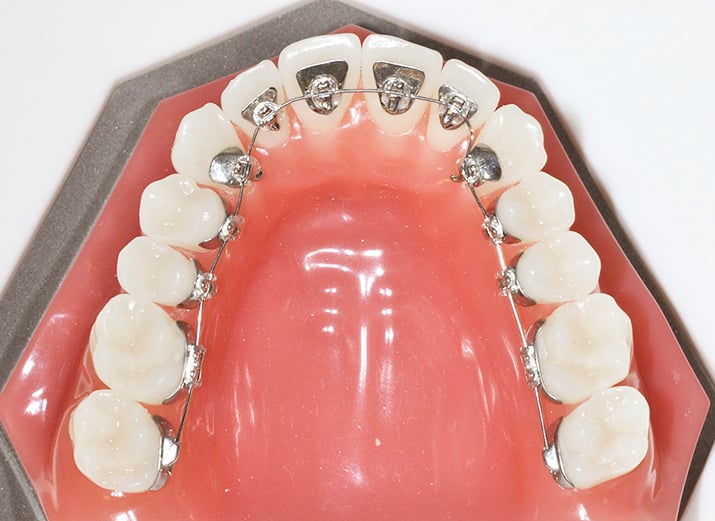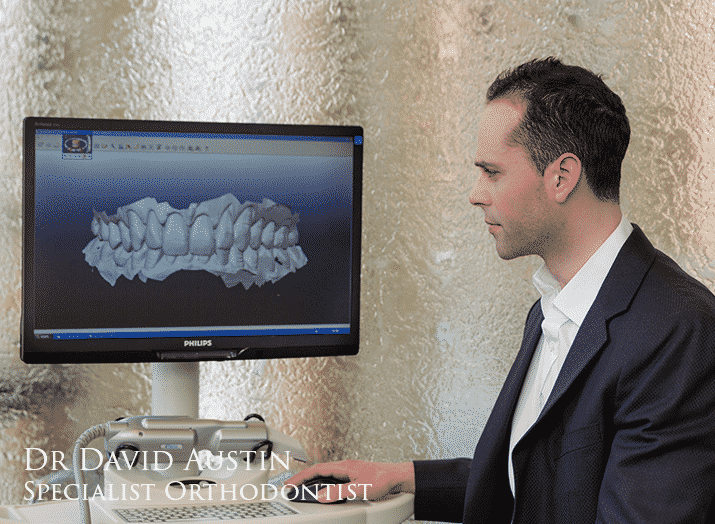Internal lingual braces – A completely invisible orthodontic solution.

How Internal Lingual Braces Compare with Other Types of Braces

Internal lingual braces straighten and realign teeth just as well as conventional braces do. However, they work a little differently, which is why additional clinician training is necessary. They are perfect for people wanting a completely hidden orthodontic treatment. Internal lingual braces are undetectable by others because they are attached to the back of the teeth, so they are hidden from view.
The biggest difference with this treatment is that it can often take a few months longer to move teeth into the desired position. Your orthodontist will give you an accurate estimation upfront of the timeframe expected in your case.
Conventional Braces
Conventional braces are metal brackets and wires fitted to the front of the teeth. They are the most common orthodontic treatment and are proven to be very effective. Some people are put off by the appearance of these braces, though, preferring the invisibility of internal lingual braces.
Clear Braces
Clear braces, like traditional braces, are fitted to the front of the teeth. They are made of a ceramic material that matches the colour of the teeth, making them less visible than traditional braces.
Invisalign
When you are treated with Invisalign, your teeth are moved into the desired position by means of clear aligners rather than wires and brackets. Invisalign relies on patient compliance in order to be effective.
For more information on Invisalign visit our Invisalign page.

What to Expect During Treatment

The treatment process for internal lingual braces begins with your orthodontist taking a three-dimensional scan of your teeth. This scan is sent to an internal lingual braces laboratory and used to create individual customised brackets for each tooth and a set of customised wires to move your teeth into the ideal position. The manufacturing process takes about 8 to 10 weeks.
At your next appointment with your orthodontist, your braces will be attached to the back of your teeth. Once the brackets are cemented in place the arch wire is attached; this will gradually move the teeth into place.
It is normal to feel slight discomfort when your braces are first fitted and you may experience a tightening sensation and tenderness when your braces are adjusted. Patients generally feel very little discomfort throughout their treatment but this can vary from individual to individual. You can take painkillers if you do feel discomfort during treatment.
Lingual braces may initially take some getting used to, with speech sometimes being affected because of the position of the brackets near the tongue. However, patients do adapt to this, and their speech quickly returns to normal.
Most likely, you will need to visit your orthodontist every six to eight weeks to have your internal lingual braces adjusted, although if your treatment is complex you may need more regular adjustments. The wires and elastics will be changed at every visit.
Frequently Asked Questions
Just like with conventional braces, some extra attention to home oral hygiene is necessary. Your clinician will show you how to clean your teeth while the braces are in place and will give you some tips on how to look after your internal braces.
You should avoid hard, crunchy or sticky foods as these could cause breakages. If any of the brackets or the wire become loose or are broken, see your orthodontist as soon as possible. You will need to have your braces promptly repaired or replaced so as not to disrupt your treatment or damage your teeth.
During any orthodontic treatment it is important to continue with your regular check-ups and cleans to make sure your teeth stay in top health. If you find it difficult to maintain good oral hygiene you may choose to have more regular cleans.
Once your braces have been removed it is highly likely your teeth will move, so a retainer will need to be worn on completion of your orthodontic treatment to ensure that the results gained are not undone. The retainer is either a clear acrylic appliance that fits over the teeth or a wire bonded to the tongue side of the teeth.
Your orthodontist will explain the type of retainer most appropriate for you and how long the retainer needs to be worn. If a wire-bonded retainer is fitted, it is usually left in place permanently.
Internal lingual braces are more expensive than conventional braces. This is because the treatment requires additional orthodontist training and these braces take longer than others to be manufactured and fitted. Also adding to the cost is the fact that both the brackets and the wires are custom-made for each patient.
The cost of your orthodontic treatment will be determined following a consultation with one of our orthodontists. Treatment complexity and hence the cost can vary greatly from one individual to another, so it is important to book in for a consultation.
At Smile Solutions your orthodontic treatment will be performed by one of our dental board–registered specialist orthodontists, each of whom has undergone the additional training required to be able to provide internal lingual braces.
Your Melbourne dentist Smile Solutions has an experienced team of orthodontists who will look after your orthodontic treatment. All of our specialist orthodontists are trained in placing internal lingual braces, and with general dentists and hygienists all working together under the same roof we make it easy for you to keep up with your dental check-ups and cleans during your orthodontic treatment.
Meet our Specialist Orthodontists
At Smile Solutions your Invisalign treatment will be carried out by one of our registered specialist orthodontists, not a general dentist. Specialist orthodontists complete a postgraduate university degree specialising in tooth and jaw correction and these are the clinicians who will assess your suitability for Invisalign and perform your treatment. You can have complete confidence in the care you receive and the final outcome.




